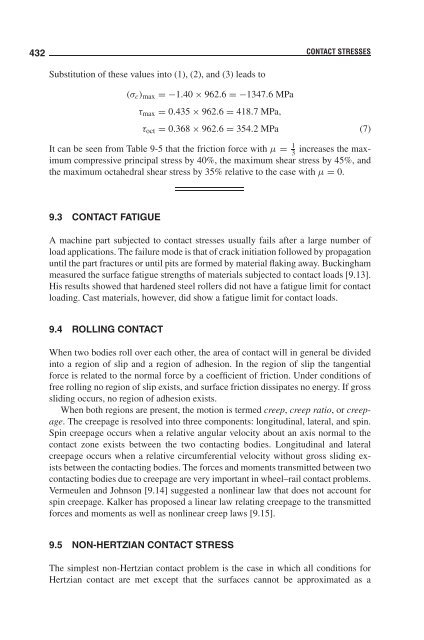9 Contact Stresses
9 Contact Stresses
9 Contact Stresses
Create successful ePaper yourself
Turn your PDF publications into a flip-book with our unique Google optimized e-Paper software.
432<br />
Substitution of these values into (1), (2), and (3) leads to<br />
(σc)max =−1.40 × 962.6 =−1347.6MPa<br />
τmax = 0.435 × 962.6 = 418.7MPa,<br />
CONTACT STRESSES<br />
τoct = 0.368 × 962.6 = 354.2MPa (7)<br />
It can be seen from Table 9-5 that the friction force with µ = 1 3 increases the maximum<br />
compressive principal stress by 40%, the maximum shear stress by 45%, and<br />
the maximum octahedral shear stress by 35% relative to the case with µ = 0.<br />
9.3 CONTACT FATIGUE<br />
A machine part subjected to contact stresses usually fails after a large number of<br />
load applications. The failure mode is that of crack initiation followed by propagation<br />
until the part fractures or until pits are formed by material flaking away. Buckingham<br />
measured the surface fatigue strengths of materials subjected to contact loads [9.13].<br />
His results showed that hardened steel rollers did not have a fatigue limit for contact<br />
loading. Cast materials, however, did show a fatigue limit for contact loads.<br />
9.4 ROLLING CONTACT<br />
When two bodies roll over each other, the area of contact will in general be divided<br />
into a region of slip and a region of adhesion. In the region of slip the tangential<br />
force is related to the normal force by a coefficient of friction. Under conditions of<br />
free rolling no region of slip exists, and surface friction dissipates no energy. If gross<br />
sliding occurs, no region of adhesion exists.<br />
When both regions are present, the motion is termed creep, creep ratio, orcreepage.<br />
The creepage is resolved into three components: longitudinal, lateral, and spin.<br />
Spin creepage occurs when a relative angular velocity about an axis normal to the<br />
contact zone exists between the two contacting bodies. Longitudinal and lateral<br />
creepage occurs when a relative circumferential velocity without gross sliding exists<br />
between the contacting bodies. The forces and moments transmitted between two<br />
contacting bodies due to creepage are very important in wheel–rail contact problems.<br />
Vermeulen and Johnson [9.14] suggested a nonlinear law that does not account for<br />
spin creepage. Kalker has proposed a linear law relating creepage to the transmitted<br />
forces and moments as well as nonlinear creep laws [9.15].<br />
9.5 NON-HERTZIAN CONTACT STRESS<br />
The simplest non-Hertzian contact problem is the case in which all conditions for<br />
Hertzian contact are met except that the surfaces cannot be approximated as a
















